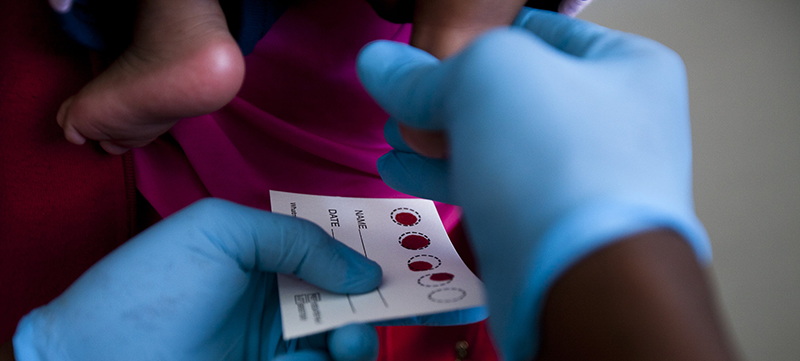Where We Work
See our interactive map


A health worker tests an infant for HIV in northern Namibia. Photo by Trevor Snapp for IntraHealth International.
The number of infants tested for HIV in the northern Namibian district of Nyangana skyrocketed over the past year—from 29.3% to 94.4%—thanks in part to a new tracking system developed by IntraHealth International.
IntraHealth nurse mentor Rightwell Zulu and district monitoring and evaluation officer Felistas Shindimba were part of the team of health workers at Nyangana District Hospital who developed the system to test nearly every baby born to HIV-positive mothers in the district. Their goal is to prevent HIV transmission in all babies in the district, and to start HIV-positive babies on treatment as soon as possible.
Today, according to the Ministry of Health and Social Services, overall HIV prevalence in Namibia is 17.2%, and highest in the northern regions. Nyangana District Hospital provides basic health services to over 38,000 Namibians in Kavango East, the region with the third-highest HIV prevalence rate in the country.
Early infant diagnosis is crucial, as HIV-positive babies face the highest risk of death within their first three months of life.
But health workers and policy-makers in Namibia have made great progress in reducing mother-to-child HIV transmission. In fact, the number of children born HIV-positive has dropped by more than 90% since 2004, said US Ambassador Thomas Daughton at an event celebrating this most recent milestone at Nyangana District Hospital.
“However,” Ambassador Daughton said, “there is no reason to relax our efforts or believe we have beaten the disease yet.”
The system Zulu and his team developed involves a detailed procedure that tracks HIV-positive mothers and ensures their babies are tested at six weeks, nine months, and 18 months after birth. This time period is critical, as infants can contract the virus through breastmilk if the mother is not taking antiretroviral medication consistently.
Before each time interval, the team calls each mother to confirm her appointment. If a client does not show up for a scheduled appointment, Shindimba picks up the phone. If that does not work, she coordinates with community health workers who then visit the mother’s village or home to ensure she and her infant get the care they need.
The system requires close coordination among the hospital’s nurses and health assistants, outreach clinic staff, and community health workers, who all work together to keep client data up to date and complete. Eventually, the team says, it will reach 100% of babies born to HIV-positive mothers, and reach their goal of zero HIV infections among babies in the region.
“Innovative platforms such as the one designed by IntraHealth, tailored to decentralized health settings, make it easy for health workers to carry out tests and follow up on babies without requiring mothers to travel long distances to the nearest hospital,” Daughton said this month. “Their tracking system is a huge success, making sure mothers and their babies remain in the system.”
IntraHealth is working with the government of Namibia to increase the number of health workers providing HIV services and provide the support and training they need to reach the country’s goal of an AIDS-free generation. IntraHealth’s USAID HIV Clinical Services Technical Assistance Project in Namibia is funded by the US Agency for International Development through the President’s Emergency Plan for AIDS Response (PEPFAR). Read more about IntraHealth’s work in Namibia.



